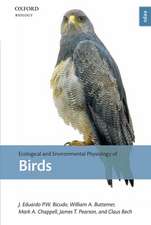Vertebrate Embryogenesis: Embryological, Cellular, and Genetic Methods: Methods in Molecular Biology, cartea 770
Editat de Francisco J. Pelegrien Limba Engleză Hardback – 2 aug 2011
Authoritative and accessible, Vertebrate Embryogenesis: Embryological, Cellular and Genetic Methods serves as an ideal guide to the molecular, cell, and developmental biology community and will hopefullycontribute to the ongoing collective effort towards a better understanding of the beauty and logic of vertebrate development.
| Toate formatele și edițiile | Preț | Express |
|---|---|---|
| Paperback (1) | 719.90 lei 6-8 săpt. | |
| Humana Press Inc. – 23 aug 2016 | 719.90 lei 6-8 săpt. | |
| Hardback (2) | 973.38 lei 6-8 săpt. | |
| Humana Press Inc. – 2 aug 2011 | 973.38 lei 6-8 săpt. | |
| Springer – 9 feb 2019 | 1127.78 lei 6-8 săpt. |
Din seria Methods in Molecular Biology
- 9%
 Preț: 791.63 lei
Preț: 791.63 lei - 23%
 Preț: 598.58 lei
Preț: 598.58 lei - 20%
 Preț: 882.98 lei
Preț: 882.98 lei -
 Preț: 252.05 lei
Preț: 252.05 lei - 5%
 Preț: 802.70 lei
Preț: 802.70 lei - 5%
 Preț: 729.61 lei
Preț: 729.61 lei - 5%
 Preț: 731.43 lei
Preț: 731.43 lei - 5%
 Preț: 741.30 lei
Preț: 741.30 lei - 5%
 Preț: 747.16 lei
Preț: 747.16 lei - 15%
 Preț: 663.45 lei
Preț: 663.45 lei - 18%
 Preț: 1025.34 lei
Preț: 1025.34 lei - 5%
 Preț: 734.57 lei
Preț: 734.57 lei - 18%
 Preț: 914.20 lei
Preț: 914.20 lei - 15%
 Preț: 664.61 lei
Preț: 664.61 lei - 15%
 Preț: 654.12 lei
Preț: 654.12 lei - 18%
 Preț: 1414.74 lei
Preț: 1414.74 lei - 5%
 Preț: 742.60 lei
Preț: 742.60 lei - 20%
 Preț: 821.65 lei
Preț: 821.65 lei - 18%
 Preț: 972.30 lei
Preț: 972.30 lei - 15%
 Preț: 660.49 lei
Preț: 660.49 lei - 5%
 Preț: 738.41 lei
Preț: 738.41 lei - 18%
 Preț: 984.92 lei
Preț: 984.92 lei - 5%
 Preț: 733.29 lei
Preț: 733.29 lei -
 Preț: 392.60 lei
Preț: 392.60 lei - 5%
 Preț: 746.26 lei
Preț: 746.26 lei - 18%
 Preț: 962.66 lei
Preț: 962.66 lei - 23%
 Preț: 860.22 lei
Preț: 860.22 lei - 15%
 Preț: 652.64 lei
Preț: 652.64 lei - 5%
 Preț: 1055.50 lei
Preț: 1055.50 lei - 23%
 Preț: 883.87 lei
Preț: 883.87 lei - 5%
 Preț: 1141.13 lei
Preț: 1141.13 lei - 19%
 Preț: 491.89 lei
Preț: 491.89 lei - 5%
 Preț: 1038.86 lei
Preț: 1038.86 lei - 5%
 Preț: 524.16 lei
Preț: 524.16 lei - 18%
 Preț: 2122.34 lei
Preț: 2122.34 lei - 5%
 Preț: 1299.23 lei
Preț: 1299.23 lei - 5%
 Preț: 1339.12 lei
Preț: 1339.12 lei - 18%
 Preț: 1390.26 lei
Preț: 1390.26 lei - 18%
 Preț: 1395.63 lei
Preț: 1395.63 lei - 18%
 Preț: 1129.65 lei
Preț: 1129.65 lei - 18%
 Preț: 1408.26 lei
Preț: 1408.26 lei - 18%
 Preț: 1124.92 lei
Preț: 1124.92 lei - 18%
 Preț: 966.27 lei
Preț: 966.27 lei - 5%
 Preț: 1299.99 lei
Preț: 1299.99 lei - 5%
 Preț: 1108.51 lei
Preț: 1108.51 lei - 5%
 Preț: 983.76 lei
Preț: 983.76 lei - 5%
 Preț: 728.16 lei
Preț: 728.16 lei - 18%
 Preț: 1118.62 lei
Preț: 1118.62 lei - 18%
 Preț: 955.25 lei
Preț: 955.25 lei - 5%
 Preț: 1035.62 lei
Preț: 1035.62 lei
Preț: 973.38 lei
Preț vechi: 1187.05 lei
-18% Nou
Puncte Express: 1460
Preț estimativ în valută:
186.28€ • 202.27$ • 156.47£
186.28€ • 202.27$ • 156.47£
Carte tipărită la comandă
Livrare economică 23 aprilie-07 mai
Preluare comenzi: 021 569.72.76
Specificații
ISBN-13: 9781617792090
ISBN-10: 1617792098
Pagini: 620
Ilustrații: XI, 605 p.
Dimensiuni: 178 x 254 x 39 mm
Greutate: 1.25 kg
Ediția:2011
Editura: Humana Press Inc.
Colecția Humana
Seria Methods in Molecular Biology
Locul publicării:Totowa, NJ, United States
ISBN-10: 1617792098
Pagini: 620
Ilustrații: XI, 605 p.
Dimensiuni: 178 x 254 x 39 mm
Greutate: 1.25 kg
Ediția:2011
Editura: Humana Press Inc.
Colecția Humana
Seria Methods in Molecular Biology
Locul publicării:Totowa, NJ, United States
Public țintă
Professional/practitionerCuprins
Approaches and Species in the History of Vertebrate Embryology.- Manipulating and Imaging the Early Xenopus laevis Embryo.- Manipulation of Gene Function in Xenopus laevis.- Developmental Genetics in Xenopus tropicalis.- Embryological and Genetic Manipulation of Chick Development.- Embryological Manipulations in Zebrafish.- Practical Approaches for Implementing Forward Genetic Strategies in Zebrafish.- Essential Techniques for Introducing Medaka to a Zebrafish Laboratory - Toward the Combined Use of Medaka and Zebrafish for Further Genetic Dissection of the Function of the Vertebrate Genome.- Ex-utero Culture and Imaging of Mouse Embryos.- Detection of Gene Expression in Mouse Embryos and Tissue Sections.- Gene Targeting in the Mouse.- Creating a “Hopeful Monster”: Mouse Forward Genetic Screens.- Assisted Reproductive Technology in Nonhuman Primates.- Embryological Methods in Ascidians: the Villefranche-sur-Mer Protocols.- Ciona Genetics.- Analyses of Gene Function in Amphioxus Embryos by Microinjection of mRNAs and Morpholino-oligonucleotides.- Reptile Embryology.- Reproductive and Developmental Manipulation of the Marsupial, the Tammar Wallaby Macropus eugenii.- Mutant Generation in Vertebrate Model Organisms by TILLING.- Inducing High Rates of Targeted Mutagenesis in Zebrafish using Zinc Finger Nucleases (ZFNs).- Derivation of Mouse Embryonic Stem Cell Lines from Blastocysts Produced by Fertilization and Somatic Cell Nuclear Transfer.- Cloning Mice and ES Cells by Nuclear Transfer from Somatic Cells and Fully Differentiated Cells.- Keeping Two Animal Systems in One Lab: A Frog Plus Fish Case Study.- Laboratory Guidelines for Animal Care.
Recenzii
From the reviews:
“Prof. Francisco J. Pelegrini … deserves the great merit of assembling a twenty-four chapters volume that will surely help researchers and educators thanks to both the choice of the topics covered (which includes even a chapter dealing with the laboratory guidelines for animal care) and to the easy-to-follow protocols that highlight each chapter.” (CarloAlberto Redi, European Journal of Histochemistry, Vol. 56, 2012)
“Prof. Francisco J. Pelegrini … deserves the great merit of assembling a twenty-four chapters volume that will surely help researchers and educators thanks to both the choice of the topics covered (which includes even a chapter dealing with the laboratory guidelines for animal care) and to the easy-to-follow protocols that highlight each chapter.” (CarloAlberto Redi, European Journal of Histochemistry, Vol. 56, 2012)
Textul de pe ultima copertă
One of the striking findings of modern developmental biology has been the high degree of conservation of signaling and developmental mechanisms amongst different animal species. Such conservation allows information learned from a given organism to be applicable to other species, including humans, and has validated the use of a few model systems to deduce general biological principles. In spite of this underlying conservation, however, each species has unique characteristics arising from its evolutionary history. Vertebrate Embryogenesis: Embryological, Cellular and Genetic Methods attempts to address the increasingly important need of straddling species boundaries in the context of a single research program by compiling research protocols used in a wide range of vertebrate species. In fact, this volume has been designed so that readers can readily find information on species other than the one with which they may be most familiar. These protocols include not only embryological methods, but also cellular and genetic approaches that have complemented and expanded our understanding of embryonic development. In addition, a number of chapters highlight a specific method that is in principle applicable to multiple species, such as TILLING and ZFN-mediated mutagenesis, the generation of Embryonic Stem (ES) cell lines, and nuclear/oocyte transfer. Written in the highly successful Methods in Molecular Biology™ series format, chapters contain introductions to their respective topics, lists of the necessary materials and reagents, step-by-step, readily reproducible laboratory protocols, and notes on troubleshooting and avoiding known pitfalls.
Authoritative and accessible, Vertebrate Embryogenesis: Embryological, Cellular and Genetic Methods serves as an ideal guide to the molecular, cell, and developmental biology community and will hopefullycontribute to the ongoing collective effort towards a better understanding of the beauty and logic of vertebrate development.
Authoritative and accessible, Vertebrate Embryogenesis: Embryological, Cellular and Genetic Methods serves as an ideal guide to the molecular, cell, and developmental biology community and will hopefullycontribute to the ongoing collective effort towards a better understanding of the beauty and logic of vertebrate development.
Caracteristici
Includes cutting-edge methods and protocols Provides step-by-step detail essential for reproducible results Contains key notes and implementation advice from the experts Includes supplementary material: sn.pub/extras








